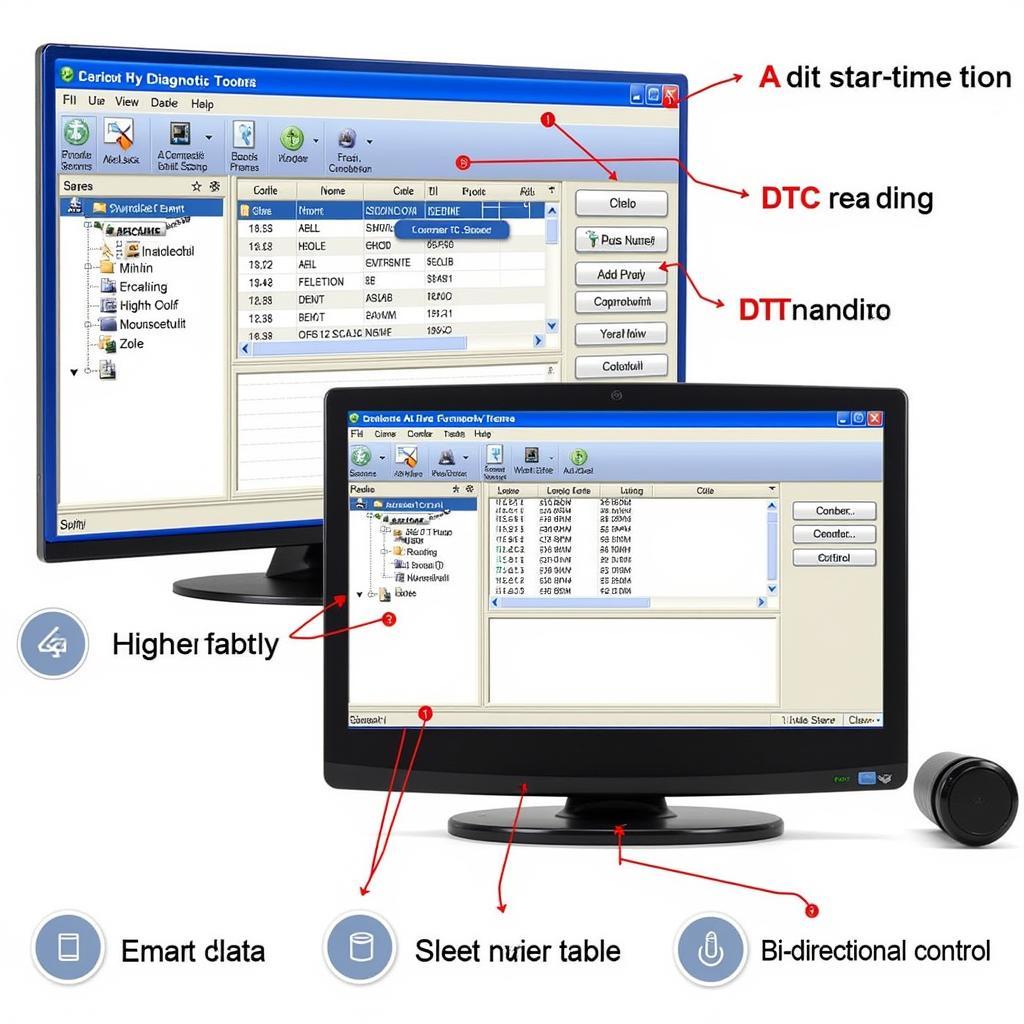A Ford Diagnostics Tool is no longer a luxury reserved for professional mechanics. As technology becomes increasingly integrated into our vehicles, understanding and interacting with your Ford’s onboard computer systems is more accessible than ever. Whether you’re a DIY enthusiast or a seasoned mechanic, a Ford diagnostics tool can empower you to diagnose and potentially fix car problems, saving you time and money in the long run.
Why You Need a Ford Diagnostics Tool
Modern Ford vehicles are equipped with intricate computer systems that monitor and control various aspects of the car’s operation. These systems generate a wealth of data, including:
- Engine performance: Fuel efficiency, ignition timing, air-fuel mixture
- Transmission behavior: Shifting patterns, gear ratios, clutch operation
- Brake system: ABS performance, traction control status, brake fluid level
- Safety features: Airbag deployment data, seatbelt pretensioners
- Comfort and convenience: Climate control settings, audio system configurations
When a problem arises, these systems trigger warning lights on your dashboard, such as the Check Engine Light, ABS Light, or Airbag Light. While these lights signal an issue, they often lack the specificity to pinpoint the exact cause. This is where a Ford diagnostics tool comes into play.
 Mechanic using a Ford diagnostics tool
Mechanic using a Ford diagnostics tool
Types of Ford Diagnostic Tools
Broadly, Ford diagnostics tools can be categorized into two types:
1. Code Readers: These are entry-level devices that primarily read and clear diagnostic trouble codes (DTCs) stored in your Ford’s computer. They are generally affordable and easy to use, making them suitable for car owners who want a basic understanding of their vehicle’s health.
2. Professional Scanners: Offering a significant leap in functionality, professional scanners delve deeper into your Ford’s systems. They provide access to live data streams, bi-directional controls (allowing you to test components), and advanced programming functions. While more expensive, they are indispensable for serious DIYers and professional mechanics.
Choosing the Right Ford Diagnostics Tool
Selecting the appropriate Ford diagnostics tool hinges on your needs and budget.
For most Ford owners, a reliable code reader that supports Ford-specific protocols will suffice. Look for features like:
- Compatibility: Ensure the tool covers the model years of your Ford vehicles.
- User-friendliness: An intuitive interface and clear instructions simplify the process.
- Code definitions: The tool should provide concise explanations of DTCs.
Advanced users and mechanics require the comprehensive capabilities of a professional scanner:
- Wide model coverage: The scanner should support a broad range of Ford and Lincoln vehicles.
- Live data streaming: Access to real-time sensor readings for in-depth diagnostics.
- Bi-directional control: Test components and execute system functions.
- Programming and coding: Update software, configure modules, and activate features.
Benefits of Using a Ford Diagnostics Tool
Investing in a Ford diagnostics tool can yield substantial benefits:
- Early problem detection: Identify minor issues before they escalate into costly repairs.
- Informed repair decisions: Understand the root cause of problems, avoiding unnecessary replacements.
- Cost savings: Diagnose and potentially fix issues yourself, reducing mechanic bills.
- Enhanced vehicle knowledge: Gain deeper insights into your Ford’s inner workings.
- Improved resale value: Maintain a well-documented service history.
Common Uses of a Ford Diagnostics Tool
A Ford diagnostics tool proves invaluable in numerous situations:
- Diagnosing engine problems: Pinpoint misfires, sensor failures, or emissions issues.
- Troubleshooting transmission issues: Identify slipping gears, solenoid problems, or TCM errors.
- Investigating ABS and traction control faults: Diagnose sensor malfunctions, module errors, or wiring issues.
- Resetting service lights: Turn off the Check Engine Light, oil change reminder, or other service indicators.
- Monitoring live data: Observe sensor readings in real time to analyze vehicle performance.
Tips for Using a Ford Diagnostics Tool Effectively
To maximize the benefits of your Ford diagnostics tool:
- Consult your vehicle’s service manual: Familiarize yourself with the location of diagnostic ports and specific procedures.
- Keep the tool’s software updated: Ensure you have the latest versions for optimal performance and vehicle compatibility.
- Record DTCs and freeze frame data: This information provides valuable context for diagnosis.
- Research codes thoroughly: Don’t rely solely on the tool’s brief descriptions; consult reputable online resources for in-depth explanations.
- Don’t attempt repairs beyond your skill level: Seek professional help for complex issues.
Conclusion
A Ford diagnostics tool is a powerful asset for any Ford owner, enabling you to take control of your vehicle’s maintenance and repairs. By understanding your car’s systems, diagnosing problems, and making informed decisions, you can save money, extend the lifespan of your Ford, and enjoy a smoother, more confident driving experience.
For expert guidance on selecting the ideal Ford diagnostics tool for your needs, contact ScanToolUS at +1 (641) 206-8880 or visit our office at 1615 S Laramie Ave, Cicero, IL 60804, USA. Our team of specialists is dedicated to providing you with the knowledge and tools to keep your Ford running smoothly.
FAQs
1. Are Ford diagnostics tools compatible with other car brands?
While some high-end scanners offer multi-make compatibility, most Ford diagnostics tools are designed specifically for Ford and Lincoln vehicles.
2. Can I update my Ford’s software using a diagnostics tool?
Yes, professional-grade scanners often include programming functions that allow software updates. However, this process requires caution and expertise, as incorrect procedures can potentially damage your vehicle’s systems.
3. Can a diagnostics tool tell me why my Check Engine Light is on?
Yes, a diagnostics tool can read the DTCs stored in your Ford’s computer, providing insight into why the Check Engine Light is illuminated. However, further diagnosis may be necessary to pinpoint the exact cause, as some codes can have multiple potential triggers.
4. Is it legal to use a Ford diagnostics tool on my own vehicle?
Yes, it is legal to use a diagnostics tool on your own vehicle in most jurisdictions. However, it’s essential to adhere to local laws and regulations regarding vehicle modifications and emissions testing.
5. Can a diagnostics tool fix my Ford’s problems automatically?
While a diagnostics tool can identify problems and sometimes guide you through basic resets, it cannot automatically fix mechanical or electrical issues. Repairs often require physical intervention by a qualified mechanic.

